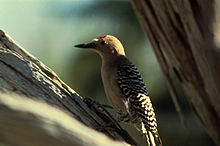Gila woodpecker
| Gila woodpecker | |
|---|---|

| |
| Scientific classification | |
| Domain: | Eukaryota |
| Kingdom: | Animalia |
| Phylum: | Chordata |
| Class: | Aves |
| Order: | Piciformes |
| Family: | Picidae |
| Genus: | Melanerpes |
| Species: | M. uropygialis
|
| Binomial name | |
| Melanerpes uropygialis (Baird, 1854)
| |
The Gila woodpecker (Melanerpes uropygialis) is a medium-sized woodpecker of the desert regions of the southwestern United States and western Mexico. In the U.S., they range through southeastern California, southern Nevada, Arizona, and New Mexico.
Habitat

This woodpecker's habitat consists of low desert scrub typical of the Sonoran Desert. They build nests in holes made in saguaro cacti[2] or mesquite trees. Cavities excavated by these woodpeckers in saguaro cacti are later used by a variety of other species, including the elf owl.[3] There, they typically lay 3–5 white eggs.
Description
The back and wings of this bird are spotted and barred with a black and white zebra-like pattern. The neck, throat, belly and head are greyish-tan in color. The male has a small red cap on the top of the head. Females and juveniles are similar, but both lack the red cap of the adult male. White wing patches are prominent in flight. The dark tail has white bars on the central tail feathers. They range from 8–10 in (20–25 cm) in length.
This woodpecker's voice is a rolling churr sound. It also makes a yip yip yip sound and a kee-u, kee-u, kee-u sound. Its drum is long and steady.
Gallery
-
In Hermosillo, Sonora, Mexico
-
A Gila woodpecker drinking water
References
- ^ Template:IUCN
- ^ Mark Elbroch; Eleanor Marie Marks; C. Diane Boretos (2001). Bird tracks and sign. Stackpole Books. p. 311. ISBN 0-8117-2696-7.
Cavities in saguaro cactuses in the Southwest are common. Both gilded flickers and Gila woodpeckers make these cavities for nesting, but they often choose different locations on the cactus.
- ^ "Gila Woodpecker". Nature Conservancy. Retrieved 2011-10-28.
Although they do not use them immediately, waiting first for the sap to harden, Gila Woodpeckers excavate cavities in cacti and trees as nesting sites.
- Robbins, C.S., Bruun, B., Zim, H.S.; Birds of North America. New York: Western Publishing Company, Inc. (1966).
External links
- The Nature Conservancy's Species Profile: Gila Woodpecker
- This Woodpecker Will Drill Into Your Skull And Eat Your Brains—If You’re a Baby Dove
- "Gila woodpecker media". Internet Bird Collection.
- Gila woodpecker photo gallery at VIREO (Drexel University)
- Interactive range map of Melanerpes uropygialis at IUCN Red List maps



